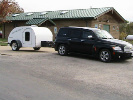HF Trailer # 90154 Grease fitting on back of hub
6 posts
• Page 1 of 1
HF Trailer # 90154 Grease fitting on back of hub
Does the fitting allow you to grease the seal and the bearing? HF manual is pretty bare bones on the subject.
-

AceMan - Platinum Donating Member
- Posts: 130
- Images: 8
- Joined: Mon Dec 20, 2010 1:26 am
- Location: Chicagoland
Ace man,
I don't own a HF trailer, so can't speak for their design, but generally if there is a grease zerk on the nose of the spindle, it is designed to carry grease to the rear or inner bearing.
(not to be confused with bearing buddy add on caps)
The "grease seal" isn't designed to be lubricated, but it does serve to contain the grease in the hub.
The front or outer bearing can be accessed by removing the hub, for regreasing.
The rear or inner bearing requires that the grease seal be removed for access.
The grease seal is usually destroyed during removal, so having a way to grease it for a few years before removal is needed (to clean and inspect) is a nice feature.
Here is a picture.
<img src="http://im1.shutterfly.com/media/47a0cf09b3127ccefbed7f20825f00000030O02AbNGjdu5bMge3nww/cC/f%3D0/ps%3D50/r%3D0/rx%3D550/ry%3D400/">
I looked up the manual, and it does suggest "greasing the seal".
Odd, as since the seals purpose is to prevent grease from coming out, the wear surface will always be exposed to grease.
Nowhere in the instructions does it say to use the zerk to lube the bearings.
It does say to remove, clean, and repack the bearings by hand every 2-3 thousand miles.
Maybe a call to their technical assistance line would get you a better answer.
Rob
HF manual
http://manuals.harborfreight.com/manual ... /90154.pdf
I don't own a HF trailer, so can't speak for their design, but generally if there is a grease zerk on the nose of the spindle, it is designed to carry grease to the rear or inner bearing.
(not to be confused with bearing buddy add on caps)
The "grease seal" isn't designed to be lubricated, but it does serve to contain the grease in the hub.
The front or outer bearing can be accessed by removing the hub, for regreasing.
The rear or inner bearing requires that the grease seal be removed for access.
The grease seal is usually destroyed during removal, so having a way to grease it for a few years before removal is needed (to clean and inspect) is a nice feature.
Here is a picture.
<img src="http://im1.shutterfly.com/media/47a0cf09b3127ccefbed7f20825f00000030O02AbNGjdu5bMge3nww/cC/f%3D0/ps%3D50/r%3D0/rx%3D550/ry%3D400/">
I looked up the manual, and it does suggest "greasing the seal".
Odd, as since the seals purpose is to prevent grease from coming out, the wear surface will always be exposed to grease.
Nowhere in the instructions does it say to use the zerk to lube the bearings.
It does say to remove, clean, and repack the bearings by hand every 2-3 thousand miles.
Maybe a call to their technical assistance line would get you a better answer.
Rob
HF manual
http://manuals.harborfreight.com/manual ... /90154.pdf
Waiting for "someday" will leave you on your deathbed wondering why you didn't just rearrange your priorities and enjoy the time you had, instead of waiting for a "better" time to come along...
-

48Rob - Super Lifetime Member
- Posts: 3882
- Images: 4
- Joined: Thu Nov 17, 2005 6:47 pm
- Location: Central Illinois



